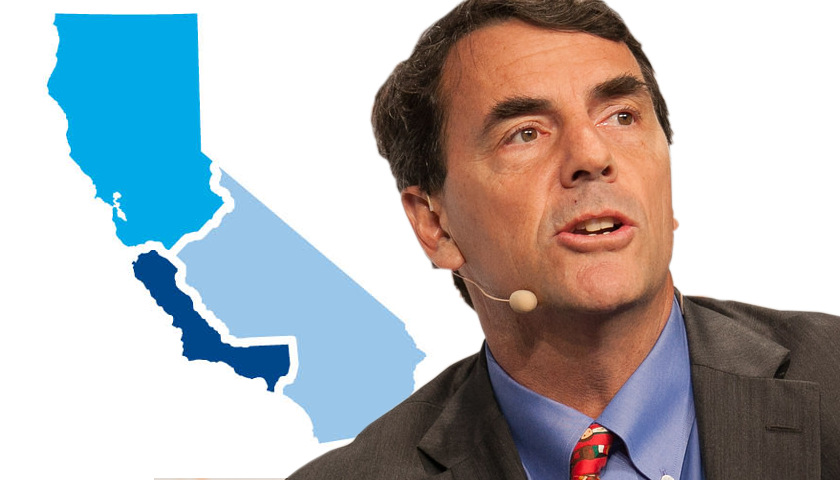by George Rasley
A controversial plan to split California into three new jurisdictions has now qualified for the Nov. 6 ballot giving voters in the Golden State the first opportunity to split a state since the creation of West Virginia in 1863.
The proposal aims to invoke Article IV, Section 3 of the U.S. Constitution, the provision guiding how an existing state can be divided into new states. The plan calls for three new entities — Northern California, California and Southern California — which would roughly divide the population of the existing state into thirds.
Conservatives are concerned that tech billionaire Tim Draper’s proposal to split California into three states would, at least in the short term, likely put more Democrats in the U.S. Senate, according to a Sacramento Bee review of voter registration and election data.
According to the Sacramento Bee, the new state of Northern California roughly covers the areas north of Merced and San Jose. Democrats outnumber Republicans two to one in the counties that would make up the state. Hillary Clinton beat Donald Trump by nearly two million votes in those counties.
The new state of California covers Los Angeles and five nearby coastal counties. The Sacramento Bee’s analysis shows Democrats outnumber Republicans by a factor of 2.5 to 1 in the counties that would make up the state. Clinton gathered nearly triple the number of votes cast for Trump in 2016.
The new state of Southern California would likely be the most competitive. It includes traditional conservative bastions like San Diego, Kern and Orange counties.
But even in that state, concluded the Sacramento Bee’s election experts, Democrats would outnumber Republicans by about 200,000. The counties that make up the proposed state cast more votes for Clinton in 2016 and former President Barack Obama in 2008 and 2012 than their Republican challengers received during those years.
The Sacramento Bee’s analysis is good counsel for Republicans and conservatives wary of giving more to power to Left Coast liberals, but there is another angle to this that is worth considering before the idea of splitting California is completely dismissed: There’s nothing in the Constitution that says new states must be admitted with the same privileges as existing states, or even that a state, once split, must be admitted at all.
Article IV Section 3 says:
New States may be admitted by the Congress into this Union; but no new State shall be formed or erected within the Jurisdiction of any other State; nor any State be formed by the Junction of two or more States, or Parts of States, without the Consent of the Legislatures of the States concerned as well as of the Congress.
The Congress shall have Power to dispose of and make all needful Rules and Regulations respecting the Territory or other Property belonging to the United States; and nothing in this Constitution shall be so construed as to Prejudice any Claims of the United States, or of any particular State.
Although an original version of the Constitution included a requirement that each new state join the Union on equal footing with the other states, the language was removed before the document was approved.
While Congress has always granted new states rights equal to those of existing states, there’s no constitutional requirement that it do so. Indeed, since that language was deleted from the final draft there’s a good argument to be made that the Framers of the Constitution wanted to preserve the power of Congress to admit states on differing bases.
What’s more, there’s no requirement that any territory petitioning for admission to the Union must be admitted.
What if California voters split the state into three new jurisdictions and Congress in its wisdom decided to admit more conservative Southern California and administer California and Northern California as territories, such as the District of Columbia, Puerto Rico and Guam are administered? There’s nothing in the Constitution that requires Congress to act otherwise.
In fact, a strict reading of the Constitution might even allow Congress to treat those two jurisdictions the same way we treat the former Trust Territories of the Pacific Islands. The Republic of the Marshall Islands, Federated States of Micronesia, Republic of Palau are sovereign states in free association with the United States.
Were the proposed new jurisdictions of California and Northern California created they could be brought into economic association with the United States on similar terms that would allow them to be as crazy left as they wanted to be, but their local government decisions would have no effect on the rest of the United States.
What’s more, we would get rid of a large number of Far-Left Democratic House members, including Democratic Leader Nancy Pelosi, and even though we would continue to take care of their defense, we would have no obligation to otherwise subsidize their liberal craziness.
For now what happens if California splits into three jurisdictions is only a thought experiment, but it is one with some interesting – and entertaining – options for conservatives.
– – –
George Rasley is editor of Richard Viguerie’s ConservativeHQ.com and is a veteran of over 300 political campaigns. A member of American MENSA, he served on the staff of Vice President Dan Quayle, as Director of Policy and Communication for Congressman Adam Putnam (FL-12) then Vice Chairman of the Oversight and Government Reform Committee’s Subcommittee on National Security and Foreign Affairs, and as spokesman for Rep. Mac Thornberry now-Chairman of the House Armed Services Committee.




